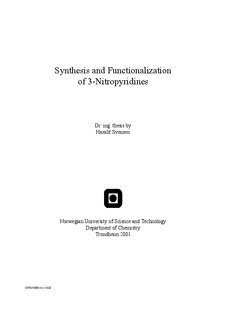Synthesis and Functionalization of 3-Nitropyridines
Doctoral thesis
Permanent lenke
http://hdl.handle.net/11250/244442Utgivelsesdato
2001Metadata
Vis full innførselSamlinger
Sammendrag
The goals for the project “Synthesis and Functionaliszation of 3-Nitropyridines” were first to further optimize the procedures for nitration of 3-nitropyridines, and then investigate some aspects of the mechanism. Further was the reactivity of 3- nitropyridines investigated, especially the reactivity toward nitrogen nucleophiles.
Pyridines can be nitrated by reacting the pyridine with dinitrogen pentoxide in an organic solvent and then pour the slurry formed into an aqueous solution of sodium bisulfite. After some hours of stirring, the 3-nitropyridine can be isolated.
After investigation of the effect of changes in sodium bisulfite concentration, reaction medium and temperature a modified procedure for the nitration was developed. In this procedure the pyridine compound was reacted with dinitrogen pentoxide in dichloromethane or nitro methane and the resulting slurry poured into a solution of bisulfite dissolved in methanol/water (3:1). After some hours of stirring at room temperature the 3-nitropyridine was isolated.
The mechanism of the nitration of pyridines with dinitrogen pentoxide was studied, and is shown in the next scheme. The author studied the migration of the nitro group from the nitrogen to the -carbon. It has been by others shown that pyridine and dinitrogen pentoxide forms N-nitro pyridinium nitrate. Which is attacked by the bisulfite nucleophile in either 2- or 4- position to give N-nitro-2- dihydropyridine-2-sulfonate and N-nitro-1,4-dihydropyridine-4-sulfonate. The nitro group in N-nitro-2-dihydropyridine-2-sulfonate migrates to the -carbon, to give via addition of one more bisulfite ion a tetrahydro intermediate. From this the 3-nitropyridine is formed by loss of two bisulfite ions. The mechanism for the nitro group migration was previously not known. The results presented in this thesis together with previous results conclude with that the migration takes place as a [1,5] sigmatropic shift.
Består av
Bakke, JM; Ranes, E; Riha, J; Svensen, H. The Synthesis of β-nitropyridine compounds. Acta Chemica Scandinavia. 53(141), 1999.Bakke, JM; Svensen, H; Ranes, E. The reaction mechanism of the nitration of pyridine compounds by N2O5 NaHSO3. J. Chem. Soc., Perkin Trans(11): 2477-2482, 1998.
Bakke, JM; Svensen, H; Trevisan, R. Selective vicarious nucleophilic amination of 3-nitropyridines. Chem. Soc., Perkin Trans. 1: 376-378, 2001.
Bakke, JM; Svensen, H. The oxidative amination of 3-nitropyridines. Tetrahedron Letters. 42(26): 4393-4395, 2001.
